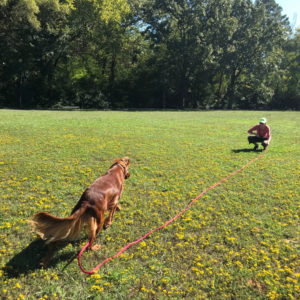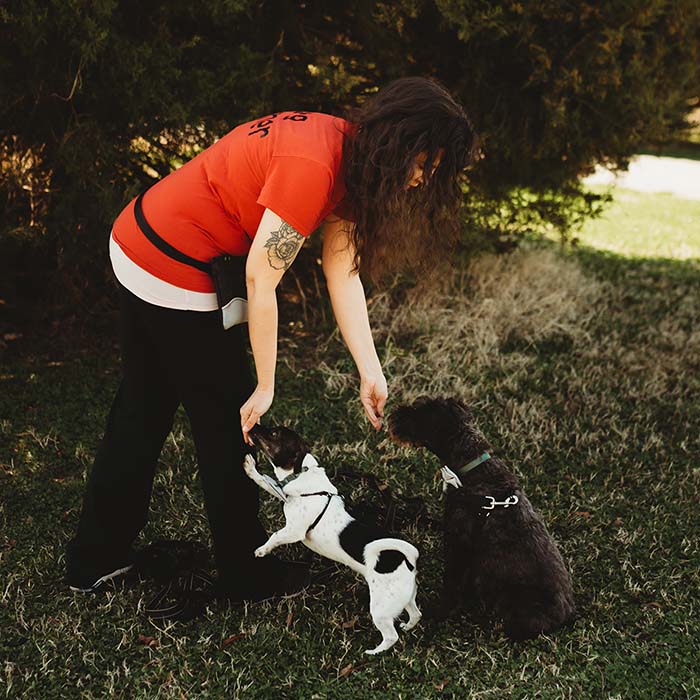Fearful Dogs
Why forcing dogs can lead to inappropriate behaviors
She was a cute little tan dog, maybe about 40 pounds, named Mouse. I was still new to the farm then, still shadowing training sessions with a more experienced trainer, when she came for a stay. The other trainer explained that we weren’t going to reach for Mouse.
Instead, we were going to play a game. We asked her to touch her nose to a wooden spoon instead of our hand, and then we tossed treats away from us. Because she was nervous and scared, we didn’t want to force an interaction she was uncomfortable with while we built up trust.
We called it “stranger danger”, and we got a lot of dogs, like Mouse, that were fearful of people. Maybe there was a reason for it. Maybe not. But we spent a lot of time understanding where a dog was and then working with them to ease through it.
It’s a method I still use. I still don’t want to touch a dog who doesn’t want me to pet them. Sometimes people assume that since I’m a dog trainer, I want to say hello to every dog I see. Instead, I’m looking at body language. I’m seeing if the dog makes eye contact with me and how they respond if they do. I also ask the owner if I can pet their dog. Sometimes they tell me no (which I respect). Sometimes they coach me through how to pet their dog, like hand under the chin (which I love). But sometimes even if they tell me yes, but the dog is telling me no, I don’t touch the dog.
Because something else happened with Mouse that day. Something I didn’t even see.
After the lesson, the other trainer told me that Mouse had curled her lip at me, and she had been about to bite me. As a new trainer, that terrified me. I hadn’t seen it. Why hadn’t she told me in the moment? How did I scare Mouse that much, and how could I avoid it in the future?
Sometimes there’s a balance in encouraging a dog and easing a dog into a new situation. If I don’t know the dog very well, I tend to ease a dog in and see what happens, because fear aggression does happen and it can be very subtle, like that lip curl I didn’t see with Mouse. I’ve found much more success more quickly by doing short sessions and gradually increasing them than by doing an immersion method. Immersion is jumping straight into the deep end without knowing how to swim. Short sessions consist of building up skills and showing how the deep end of the pool isn’t all that scary with the right knowledge and set up.
The signs of fear can vary from dog to dog. Sometimes it’s a lip curl. Sometimes it’s raised hackles. Sometimes it’s a tail tuck or simply trying to run away.
But some easy steps can help a fearful dog, depending on the situation:
- Allow for distance and retreat. One of the biggest methods we used with Mouse was that she was allowed to end the training sessions whenever she wanted to, and we provided distance between us when it was time for her to get a reward. This allows for choice and control in a situation where a dog feels very helpless. When we force a dog to do something, despite their fear or even their pain, this can lead to learned helplessness. I was at a shelter recently, watching a volunteer hold the leash of a dog who was simply lying on the ground, not moving. Another person asked about the dog, and the volunteer explained the dog had been severely abused. The person asked to pet the dog, and the volunteer said it was fine. The dog did not react or respond to the petting, and the other person found it odd. He was used to dogs backing up into a corner when afraid. Learned helplessness teaches dogs that it doesn’t matter what they do, so they learn not to react at all, living quietly in fear and anxiety, much like the dogs in the experiment Seligman conducted.
- Toss treats instead of forcing a dog to take the treat directly from your hand. While this can be a wonderful goal to build up to, allowing a dog to find the treat on the floor instead of the hand when the dog is afraid helps to build up trust much more quickly.
- Do short sessions and allow the dog to decide when they are done. Like with Mouse, this gives the dog a chance to have some control in a situation where they feel very unsafe.
- Don’t take it personally. Sometimes dogs are afraid because they’re going through a developmental change. Sometimes they’re afraid because something happened. Sometimes it’s just their personality. There are a lot of reasons why a dog might react in fear or not want to interact with a person or even other dogs. Like humans, they also have their preferences and their moods. They might not be feeling well. For every dog that doesn’t want to say hello, there will be ten others that would it love very much.
Group classes take place every Saturday at SoMa Animal Clinic. I also offer private in-home lessons in the Little Rock area and training walks for current clients. Email me at info@telltaildogtraining.com for more information.



